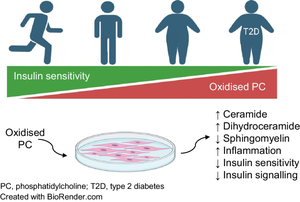Diabetologia ( IF 8.4 ) Pub Date : 2024-09-30 , DOI: 10.1007/s00125-024-06280-8 Karin A. Zemski Berry, Amanda Garfield, Purevsuren Jambal, Simona Zarini, Leigh Perreault, Bryan C. Bergman

|
Aims/hypothesis
Intracellular ceramide accumulation in specific cellular compartments is a potential mechanism explaining muscle insulin resistance in the pathogenesis of type 2 diabetes. Muscle sarcolemmal ceramide accumulation negatively impacts insulin sensitivity in humans, but the mechanism explaining this localised accumulation is unknown. Previous reports revealed that circulating oxidised LDL is elevated in serum of individuals with obesity and type 2 diabetes. Oxidised phosphatidylcholine, which is present in oxidised LDL, has previously been linked to ceramide pathway activation, and could contribute to localised ceramide accumulation in skeletal muscle. We hypothesised that oxidised phosphatidylcholine inversely correlates with insulin sensitivity in serum, and induces sarcolemmal ceramide accumulation and decreases insulin sensitivity in muscle.
Methods
We used LC-MS/MS to quantify specific oxidised phosphatidylcholine species in serum from a cross-sectional study of 58 well-characterised individuals spanning the physiological range of insulin sensitivity. We also performed in vitro experiments in rat L6 myotubes interrogating the role of specific oxidised phosphatidylcholine species in promoting sarcolemmal ceramide accumulation, inflammation and insulin resistance in skeletal muscle cells.
Results
Human serum oxidised phosphatidylcholine levels are elevated in individuals with obesity and type 2 diabetes, inversely correlated with insulin sensitivity, and positively correlated with sarcolemmal C18:0 ceramide levels in skeletal muscle. Specific oxidised phosphatidylcholine species, particularly 1-palmitoyl-2-(5-oxovaleroyl)-sn-glycero-3-phosphocholine (POVPC), increase total ceramide and dihydroceramide and decrease total sphingomyelin in the sarcolemma of L6 myotubes by de novo ceramide synthesis and sphingomyelinase activation. POVPC also increases inflammatory signalling and causes insulin resistance in L6 myotubes.
Conclusions/interpretation
These data suggest that circulating oxidised phosphatidylcholine species promote ceramide accumulation and decrease insulin sensitivity in muscle, help explain localised sphingolipid accumulation and muscle inflammatory response, and highlight oxidised phosphatidylcholine species as potential targets to combat insulin resistance.
Graphical Abstract
中文翻译:

氧化磷脂酰胆碱诱导骨骼肌肌膜神经酰胺积累和胰岛素抵抗
目标/假设
细胞内神经酰胺在特定细胞区室中的积累是解释 2 型糖尿病发病机制中肌肉胰岛素抵抗的潜在机制。肌肉肌膜神经酰胺的积累会对人类的胰岛素敏感性产生负面影响,但解释这种局部积累的机制尚不清楚。先前的报告显示,肥胖和 2 型糖尿病患者的血清中循环氧化 LDL 升高。氧化磷脂酰胆碱存在于氧化低密度脂蛋白中,此前已被认为与神经酰胺途径激活有关,并可能有助于骨骼肌中局部神经酰胺的积累。我们假设氧化磷脂酰胆碱与血清中的胰岛素敏感性呈负相关,并诱导肌膜神经酰胺积累并降低肌肉中的胰岛素敏感性。
方法
我们使用 LC-MS/MS 来量化血清中特定氧化磷脂酰胆碱的种类,该研究对 58 名具有良好特征的个体进行了横断面研究,涵盖了胰岛素敏感性的生理范围。我们还在大鼠 L6 肌管中进行了体外实验,探讨特定氧化磷脂酰胆碱种类在促进骨骼肌细胞肌膜神经酰胺积累、炎症和胰岛素抵抗中的作用。
结果
Human serum oxidised phosphatidylcholine levels are elevated in individuals with obesity and type 2 diabetes, inversely correlated with insulin sensitivity, and positively correlated with sarcolemmal C18:0 ceramide levels in skeletal muscle. Specific oxidised phosphatidylcholine species, particularly 1-palmitoyl-2-(5-oxovaleroyl)-sn-glycero-3-phosphocholine (POVPC), increase total ceramide and dihydroceramide and decrease total sphingomyelin in the sarcolemma of L6 myotubes by de novo ceramide synthesis and sphingomyelinase activation. POVPC also increases inflammatory signalling and causes insulin resistance in L6 myotubes.
结论/解释
这些数据表明,循环中的氧化磷脂酰胆碱物质促进神经酰胺积累并降低肌肉中的胰岛素敏感性,有助于解释局部鞘脂积累和肌肉炎症反应,并强调氧化磷脂酰胆碱物质是对抗胰岛素抵抗的潜在目标。


















































 京公网安备 11010802027423号
京公网安备 11010802027423号